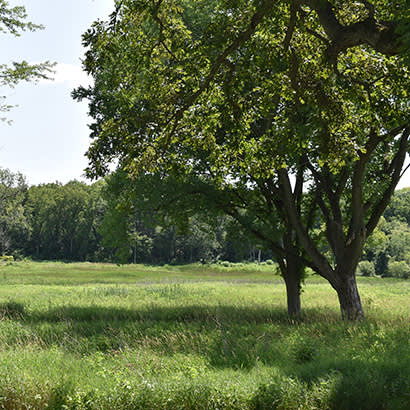
For an enhanced digital experience, read this story in the ezine.
Skunk cabbage reaches through the ground just as winter recedes in Crystal Lake, Illinois’ Sterne’s Woods and Fen and Veteran Acres Park. John Fiorina, Crystal Lake Park District (CLPD) manager of interpretive services, describes its shape as a crab claw. Preston Skultety, CLPD manager of natural resources, says, “It’s a modified leaf, and it’s a deep, reddish mottled color [that] almost looks like it would be like lizard skin.” The plant emerges in areas where the park district and volunteers have cleared aggressive introduced species to allow Indigenous species to thrive. The park district embraces opportunities to educate the community on the notable features within the space, from the small skunk cabbage to the rare fen wetlands, encouraging the public to protect the parkland for present and future generations.
In 1994, following local naturalist Bill Wingate’s efforts to steward and protect the area, Sterne’s Woods and Fen was designated as an Illinois Nature Preserve, protecting rare fen wetlands present in the space. “One of the things that makes Sterne’s Woods and Fen unique is the fen because of the rarity of the fen and what makes a fen,” says Skultety. “The area was carved by the glaciers, and the deposits from the glaciers are gravel heavy up in the hillsides.”
According to the U.S. Forest Service, “Fens are peat-forming wetlands that rely on groundwater input and require thousands of years to develop and cannot easily be restored once destroyed.” The park district has completed extensive hydrologic restoration work to reduce erosion and regenerate wetlands where infrastructure added throughout the decades, like horse tracks, has disturbed the water-outflow patterns, says Fiorina. The restoration work will not only improve ecosystem health, but also public safety by reducing the potential for flooding in the area.
Stewardship Decisions
Park and recreation agencies sometimes must consider their communities’ attachment to certain species they’ve come to associate with a park, such as the rows of towering pines within Sterne’s Woods and Fen and Veteran Acres Park, when making decisions. Originally planted as lumber when the land was a tree farm, the pines draw visitors in for exploration, recreation and, very commonly, hammocking, thanks to the even spacing of the trees. However, they are not Indigenous to the area.
“In the past, there was interest from the ecological community, even among volunteers who work on the site, in thinning out some of the evergreens, but the public wasn’t warming up to that idea because the pine groves had always been something they identified the site with,” says Skultety.
“Ecologically, we should remove them,” says Fiorina, “but because of the emotional attachment that a lot of our residents have, we say, ‘Alright, we will leave them be, and we’ll fight the fight of cutting out the buckthorn and the honeysuckle that are truly invasive, non-native European species.’”
Immersive Education
From the remnants of glaciers to the characteristic “claws” of the skunk cabbage, Sterne’s Woods and Fen and Veteran Acres Park hold countless opportunities for recreation and education. “It’s fun to get people to experience [the area] with all their senses,” says Skultety. “There are plants that shoot seeds when you touch them and things that have unique smells that are really fun to show to people because it’s very memorable.”
CLPD’s programming and volunteer opportunities invite community members to get to know the area from an ecological perspective and take note of the rare attributes within the space, cultivating a greater understanding of and appreciation for nature and biodiversity. “That’s why I do what I do,” says Fiorina. “What I try to do is get people to love it because if you love it, you’ll vote to protect it.”
SEE ALSO: “Conservation Lands as Critical Public Infrastructure,” Robert Smet, Parks & Recreation, September 2018, Vol. 53, Iss. 9.
Alexandra Reynolds is Associate Editor of Parks & Recreation magazine.


